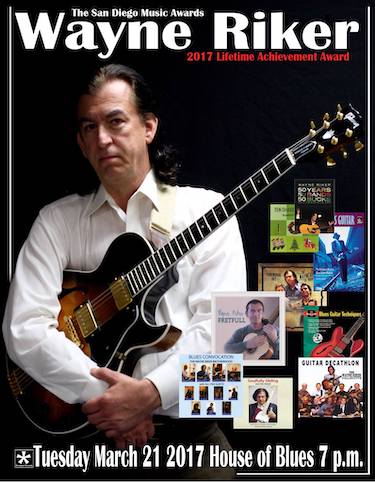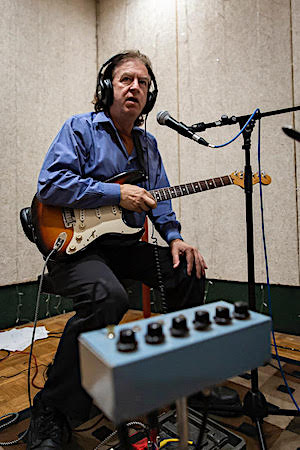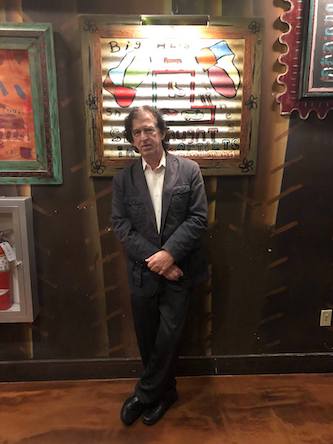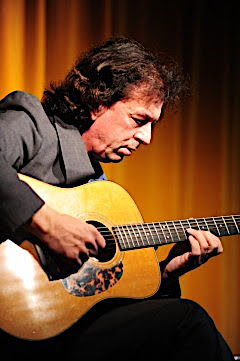 
|
||||
|
|
THE WAYNE RIKER GATHERING |
|||
|
mwe3.com presents an interview with
Wayne Riker: I grew up in New York City, in the Bronx, and wound up in San Diego when I was 29 years old when engaged at the time to a woman who was from San Diego County. The IRT line at 242nd Street was my main subway line into Manhattan. For many growing up in New York City, it’s all we know, so when I eventually traveled more, I realized I preferred greener pastures over steel and concrete. Love the lifestyle and laid back vibe in San Diego ever since moving here in 1980. Don’t get back much to the Big Apple other than class reunions and what little family remains there. mwe3: You said you played your first gig in the Village at the Café Bizarre. What street was it on and what year was that? How did you develop such an eclectic taste in music and have you played just about every style of music in your career? I guess you grew up when guitarists like Clapton and Hendrix were all the rage. Wayne Riker: My first gig was at the Cafe Bizarre in Greenwich Village in the summer of 1967, located at 106 West 3rd Street. My goal on guitar was to learn as many styles as I could to increase my range of employment in addition to being a connoisseur of all genres of music. Yes, lots of great guitarists to emulate at the time including Johnny Winter, Mike Bloomfield, John McLaughlin, Jerry Hahn, Jeff Beck, Jimmy Page to name a few at the time in addition to Clapton and Hendrix. mwe3: When did you start playing guitar and what were some of your early guitars? What other bands from that era influenced you and were you into Top 40 or other genres, jazz, blues and folk in the late 1960s and early ‘70s? Wayne Riker: I started playing guitar in the summer of 1965. My first guitar was an acoustic Stella guitar, followed by an Ibanez electric, a Hagstrom electric and a Les Paul Custom electric. In addition to the huge influence of the Beatles, I learned many tunes initially on my own including Folk, R&B and Top 40 as starters. Many of the groups and artists I memorized tunes from were Bob Dylan, The Yardbirds, James Brown, The Animals, The Rolling Stones, The Byrds, Wilson Pickett, Janis Ian, to name a few. After that I transitioned into blues and jazz artists, learning tunes from B.B. King, John Mayall, The Electric Flag, Muddy Waters, Paul Butterfield, Savoy Brown, Freddie King, to name a few from blues and Larry Coryell, Howard Roberts, Pat Martino, Wes Montgomery, George Benson to name a few from jazz.
Wayne Riker: Blues Lightning is my 13th album. Most of them have been done with the same blueprint, spotlighting musical artists on individual tracks so as to create a compilation album of musical all stars. On Blues Lightning there are six lead vocalists each spotlighted on individual tracks along with two backup singers appearing on four of the tracks. I chose six tracks total to fit in with the contemporary short attention spans of most listeners. Even at 23 minutes in length, that can be a challenge for most to keep rapt attention. As far as the organizational part, I first choose the tunes I think will work well with blues aficionado consumers. Then I choose tunes that have high energy and are easy to tap your foot to and are somewhat standard blues repertoire tunes. Like a dance set in a club, I use the same formula, three tunes in a row with high energy and medium fast tempos followed by a slow tempo ballad in preferably a minor key, concluding with two up-tempo tunes to close it out. Most of the musicians and special guests I gather together are some that I’ve worked with before and others that I’ve never met but know of their reputation through mutual friends. I have a fondness for giving many an opportunity to record and share the limelight with. mwe3: Was it challenging recording during the pandemic of 2020? Some of the album was recorded before the pandemic too? How has the pandemic affected your playing, teaching and recording these past eight months? Where do you see this global crisis heading as well approach the new year of 2021? Wayne Riker: Yes, the musical tracks were laid down pre pandemic along with my guitar solos and fills. The studio was operating during the pandemic under strict guidelines so each singer came in individually, all masked and social distanced with all mics and surfaces being wiped down with never more than me, the engineer and vocalist in attendance. I teach summer guitar clinics each year that were all cancelled like everything else, along with a few street fair performances that were cancelled. With the advent of vaccines and new leadership here in the U.S. heading into 2021, I’m feeling hopeful for that much needed return to normalcy.
Wayne Riker: My memoirs book tells most of my story, which can be ordered on Amazon. I've authored nine instructional blues books with Alfred Publishing and a chord usage book that I’ve self-published. So far, 13 CD’s, ten instrumental, three solo, seven with full bands, and three with vocals and full bands. My goal was to become a guitar teacher and gig guy right from the start. Both began in 1973 after I graduated from college. I began teaching from my home until I got hired to teach at various guitar shops over the years. I was fortunate to be hired by the National Guitar Summer Workshop in 1990, a distinguished guitar summer camp that was well established on the east coast since 1984. They auditioned faculty for a California campus which I interviewed for and got hired for their inaugural year in 1990. During that time I was in the right place at the right time as they wanted teachers to write a curriculum for each course. I was the main blues faculty guy, so I accepted the task. In 1992 Alfred Publishing was looking to expand their book catalog to more contemporary styles. The camp directors met with them and the ball started rolling for the faculty to produce full length books covering most all contemporary genres. After the success of my first book, Mastering Blues Guitar, eight more followed between 1994-2006. mwe3: Tell us about the different guitar styles you play, from blues-rock to jazz, fusion and even rock. You’ve also done instrumental albums too? Contrast recording blues-rock music with instrumentals and also rock. It seems like you thrive in a lot of different guitar styles and genres. I have the same belief in that I don’t care what the style is as long as there’s a guitar in the mix! lol I studied classical guitar too and it led me to understand how a lot of the great guitarists also started on a classical guitar. Wayne Riker: Between transcribing many different guitar styles for students, my own self-study of different genres and having to learn guitar parts for a mixed variety of gigs, everything began to meld into my multi-genre career. As far as the recordings, the original instrumental tunes were very self-satisfying to create and record, but I found doing vocal albums with cover tunes brings in a wider audience and a more universal response.
Wayne Riker: The Gibson Howard Roberts guitar does have a sentimental story to it. I attended Roberts’ Guitar Institute Of Technology in 1979. I took a year off from gigging to study at the school in Hollywood. He was one of my teachers along with a host of other guitar luminaries. At the end of the year, a Howard Roberts model was given to the most accomplished student; I finished second. Fast forward to 2011 and I spot a Howard Roberts model being sold at the guitar shop I was teaching at. Without a second thought I purchased it immediately. Felt good to own it after the backstory of its history. On Blues Lightning, all the rhythm guitar parts and solos were done on the Fenders. I used the Gibson for some of the fills and the slide guitar parts on track 3. In addition to those electrics I have one acoustic guitar, a Stonebridge guitar, made in Eastern Europe, love it. I use a Roland cube amp, great selection of effects. mwe3: How do you stay in shape both as a guitarist and composer? How would you describe your guitar technique and do you use a pick and/or also play with your fingers? Do you still practice every day or do you spend most of your time composing and/or performing? Wayne Riker: As I work on each recording practice, that tends to be my practice time as well. For most lead parts I use a pick, a Big Stubby made by Dunlop. I use my fingers quite a bit for chords. On my first two albums, Fretfull and Fretology, I fingerpicked entirely, all on acoustic guitars. mwe3: How can you get more of your music out in front of people? I guess the pandemic of 2020 has brought havoc on live music. Where do you see the live concert scene going in the next six months to a year? Wayne Riker: Looks like the drive in concerts are working well, but once the pandemic is in the rear view mirror, live gigs should make a solid comeback.
Wayne Riker: My dream album is in the works. In January, 2021, I’ll be recording a solo album entitled A Beatles Overture from A to Z, featuring all Beatles titles from A to Z—including 21 tunes as there are no Beatles titles that start with five of the 26 alphabetical letters! Each tune will feature chord melodies of each tune followed by rollicking overdubbed blues-rock type solos over the basic chord patterns of each song. The total running time will be around 42 minutes with tune lengths between a little over a minute to two and a half minutes. It will track as one continuous symphony with a minimal space between each tune. Very unique and excited for all to hear!
|
|
|||
|
||||

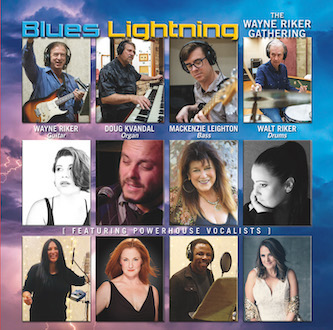 Bronx-born, San Diego-based guitarist Wayne Riker strikes blues-rock gold with his 2020 CD, Blues Lightning. Spotlighting The Wayne Riker Gathering, the Blues Lightning CD may contain only six tracks yet, start to finish it’s packed with loads of solid blues-rock action with each of the tracks spotlighting Wayne’s sizzling lead guitar work and his band-leading skills. Key to the album is the six different lead singers that take the vocal spotlight on each of their respective tunes. With the vocalists taking turns on their different tracks, Wayne’s core band features some excellent players, including Doug Kvandal (organ), Mackenzie Leighton (bass) and Walt Riker (drums). A live-in-the-studio album, Blues Lightning offers both a close-up view of Wayne's live band in action as well as a studio recording that makes the most of an intimate set performed live in front of an appreciative audience. A multi-tasking guitarist that has been performing and teaching since 1973, Wayne has also released ten guitar instruction books and he’s also been an instructional guitar columnist since 1998. You can pick up on Wayne's story via his 2017 autobiography 50 Years, 50 Bands, 50 Bucks. Having released three solo albums and ten group recordings under his own name, Blues Lightning is a very cool album to pick up on the white-hot, blues-rock sound of Wayne Riker.
Bronx-born, San Diego-based guitarist Wayne Riker strikes blues-rock gold with his 2020 CD, Blues Lightning. Spotlighting The Wayne Riker Gathering, the Blues Lightning CD may contain only six tracks yet, start to finish it’s packed with loads of solid blues-rock action with each of the tracks spotlighting Wayne’s sizzling lead guitar work and his band-leading skills. Key to the album is the six different lead singers that take the vocal spotlight on each of their respective tunes. With the vocalists taking turns on their different tracks, Wayne’s core band features some excellent players, including Doug Kvandal (organ), Mackenzie Leighton (bass) and Walt Riker (drums). A live-in-the-studio album, Blues Lightning offers both a close-up view of Wayne's live band in action as well as a studio recording that makes the most of an intimate set performed live in front of an appreciative audience. A multi-tasking guitarist that has been performing and teaching since 1973, Wayne has also released ten guitar instruction books and he’s also been an instructional guitar columnist since 1998. You can pick up on Wayne's story via his 2017 autobiography 50 Years, 50 Bands, 50 Bucks. Having released three solo albums and ten group recordings under his own name, Blues Lightning is a very cool album to pick up on the white-hot, blues-rock sound of Wayne Riker. 